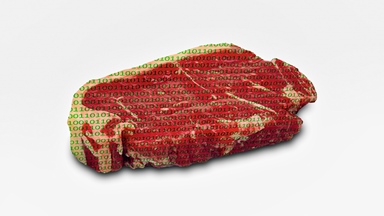Loading component...
At a glance
Singapore’s commitment to innovation was on display – and on the menu – at the 2022 United Nations Climate Change Conference, COP27, held in Sharm El‑Sheikh, Egypt.
At a series of events co‑hosted by the Singapore Government, food‑tech start‑up GOOD Meat served guests chicken, but not as they knew it.
The chicken had not been farmed. It had been grown in a Singapore laboratory and is an example of “cultivated meat”, which has been available for commercial sale in the city‑state since 2020.
As it is produced from animal cells, cultivated meat looks, smells and, by most accounts, tastes, just like the “real thing”. Proponents point to its animal welfare benefits, as well as its ability to shore up food security for a growing global population.
However, lab‑grown meat must first overcome obstacles around scaling, funding and consumer acceptance.
Appetite for innovation
Cultivating meat in a lab involves a biopsy to remove animal cells from a live animal, then nurturing the cells in a bioreactor, which simulates the conditions in which they would normally grow.
Cells are bathed in temperature‑controlled, nutrient‑rich broth and grown on a “scaffold” of edible materials to provide texture and structure as cells replicate.
In June 2023, the US became the second place in the world to approve cultivated meat for sale when it gave the “green light” to two California‑based companies, UPSIDE Foods and GOOD Meat. Meanwhile, Food Standards Australia New Zealand is currently considering an application from cultivated meat company Vow to approve its products for commercial sale.
Since 2016, cultivated meat companies have attracted approximately US$2.78 billion (A$4.28 billion) in funding. In Asia‑Pacific, they raised more capital in 2022 than in all prior years combined.
There are several reasons for this growth. With the global population predicted to grow to 10 billion in the next three decades, attention is shifting to secure sustainable food sources. Meeting net‑zero emissions by 2050 will also require reducing the food industry’s carbon footprint.
Food production is a significant contributor to greenhouse gas emissions, and animal‑based foods are responsible for about twice the emissions of plant‑based ones.
“More than 56 per cent of the world’s habitable land is used for agriculture and, of that, 75 per cent is used for animal agriculture, either in grazing animals or in growing feed to give to animals,” says Dr Simon Eassom, executive director of Food Frontier, an independent think tank on alternative proteins in Australia and New Zealand.
“It’s a massive impost on the environment.”
Dr Crispin Howitt, future protein mission lead at CSIRO, says innovations in science and food technology will be essential in meeting a growing demand for protein.
“As we, essentially, have no more agricultural land available to meet this increased demand, new forms of protein production are not competing with existing ones – they’re actually complementing them and helping to meet a growing demand,” Howitt says.
“We’ve moved from calling it ‘alternative protein’ to ‘complementary protein’, because we are very conscious that the world may have another two billion people to feed by 2050,” Howitt adds.
“We’re also seeing a shift in demographics, particularly in Asia, where more people are moving into what are considered middle‑class incomes. We know from watching other countries that when that kind of shift happens, protein intake increases. It’s a simple correlation – when you have money to spend, you spend more on food.”
A taste of Singapore

The world’s first lab‑grown burger was produced in 2013 by Dutch scientist Professor Mark Post of Maastricht University. It cost about US$375,000 (A$576,750) to make, due to the ground‑breaking nature of the science.
Today, there are more than 150 cultivated meat companies around the globe, and the cost of production is shrinking. However, it is still much higher than conventional meat production.
A recent analysis published in the Journal of Agriculture and Food Research suggests that cultured meat would cost about US$63 (A$97) a kilogram to produce in a large‑scale facility. The three major costs of production are the cell‑culture medium, bioreactors and labour.
Singapore is considered the heart of alternative protein production, with the country investing US$104 million (A$160 million) in its Singapore Food Story R&D Programme.
Mirte Gosker, managing director Asia‑Pacific of Singapore’s Good Food Institute (GFI), says food security is a key driver of Singapore’s investment.
"With all of these wheels in motion, we expect that cultivated meat will be at least theoretically available to consumers in many, if not most, of Asia’s biggest markets in five years’ time. But it will still be a long way off from achieving price parity with conventional meat while the industry scales up manufacturing capacity across the continent."
“The land‑scarce city‑state currently imports more than 90 per cent of its food,” she says.
“It rightly sees alternative proteins as a potential solution to meet its ‘30 by 30’ goal of producing at least 30 per cent of its nutritional needs by 2030, thereby boosting resilience to global food supply shocks.”
Eassom adds that Singapore’s “business friendly environment for technology” allows it to attract innovative companies.
“Singapore is also a melting pot of Asian and Western cultures, so they are used to eating all different types of cuisine,” he says.
“Our research shows that, more than any other nation in Asia, Singapore has the most positive attitude towards trying a new food such as cultivated meat. In fact, 39 per cent of consumers in Singapore have said they will, or are likely to, try cultivated meat when they have an opportunity.”
Roadblocks to success
Appetites for alternative proteins are growing, but cultivated meat still faces significant challenges to becoming a major industry.
Data from McKinsey shows reaching a US$25 billion (A$38 billion) market by 2030 will require the annual production of 1.5 million tonnes of cultivated meat.
“Developing the quantities you need to feed the market – and building the infrastructure to produce those quantities – is a very difficult proposition, because most of the bioreactors that you might use in this process are already being assigned and used in industries like pharmaceuticals,” Eassom says.
Dr Peter Valtchev, industrial research manager at the University of Sydney’s Centre for Advanced Food Engineering, says creating a desirable texture is another challenge for the industry.
“The reality is that we have been able to grow cells in a bioreactor and in cell culture for decades, but there is a big difference between cells and tissue,” he says. “To form tissue, there is a huge gap that hasn’t been bridged yet.”
Valtchev explains that, since cells are “essentially about 70 per cent water”, combining them in large quantities creates a soup‑like texture.
Howitt adds that developing a meat‑like texture is a focus of ongoing research.
“There are also some aspects of research around creating an edible framework that the cells grow in that help to give that texture,” Howitt says. “Some are talking about 3D printing matrices that are edible and then growing the cells in them.”
To become a truly effective global food solution, cultivated meat must also overcome a major obstacle of consumer acceptance.
“A big challenge is people’s aversion to what they think is ‘Frankenstein food’, or lab‑produced food – that is not ‘natural’ or is ‘artificial’,” Eassom adds.
“All food technology takes place in laboratories, and, if you want to talk about ‘Frankenstein food’, just think about the interventions that go into producing the 80 billion chickens people consume every year that are fully grown and ready for slaughter within five to six weeks of hatching.”
Can edible bugs solve the West's food shortage fears?
Green credential check
Even if the cultivated meat industry can overcome these challenges, will it really offer a sustainable alternative to the traditional meat industry?
The Intergovernmental Panel on Climate Change’s 2022 assessment report says that alternative proteins like cultivated meat could help to reduce global emissions from food production, because of their “lower land, water and nutrient footprints”.
However, as cultivated meat is not yet produced at an industrial scale, estimates of its carbon footprint are largely based on scientific and engineering models.
Few studies have quantified the amount of fresh surface and groundwater required to grow meat in a lab. However, a study conducted by Dutch research firm CE Delft, commissioned by the Good Food Institute, indicates an up to 78 per cent reduction as compared to beef production.
In contrast, researchers at the University of California, Davis, have found that the environmental impact of cultivated meat is likely to be “orders of magnitude” higher than that of retail beef, based on current and near‑term production methods.
"Developing the quantities you need to feed the market – and building the infrastructure to produce those quantities – is a very difficult proposition, because most of the bioreactors that you might use in this process are already being assigned and used in industries like pharmaceuticals."
Gosker notes that these findings have not been peer‑reviewed and are based on the researchers’ assumptions about using costly pharmaceutical‑grade media for cultivated meat production.
She says the assumptions are “misaligned with current industry practices”, as many cultivated meat companies currently use cheaper food‑grade ingredients.
Eassom adds that, without data on the energy inputs of producing cultivated meat, it is hard to determine how its environmental impact will compare to traditional animal agriculture.
“The truth is, we don’t really know how sustainable the cultivated meat industry is just yet,” he says.
“It’s extremely difficult to measure the specific environmental impact for any aspect of agriculture, unless the company producing the food is prepared to give you all their sourcing, production and supply chain data. As a result, nearly all of the assessments are based on assumptions and certain parameters.”
However, with the use of renewable energy, Eassom says the opportunity for the cultivated meat industry to emit far less greenhouse gas than the animal agriculture industry is “enormous”.
“This is because cultivated meat has zero methane production,” he says. “Ruminating animals belch methane and, as we know, methane emissions are more damaging than CO2 from fossil fuels. They cannot be sequestered and cannot be absorbed by carbon‑absorbing plants or the sea.”
From lab to plate

Production costs for cultivated meat today remain well above those of conventional animal protein. According to McKinsey analysis, however, about 75 per cent of costs can be eliminated through increased scale and superior manufacturing processes. Further costs may be cut by fine‑tuning processes and by blending cultivated meats with plant protein.
“I’m positive about the industry, and I believe that maybe in about 20 years we’ll get there,” Valtchev says. “But it’s important to note that the current obstacles are more than just enough finance to scale or to optimise existing processes. The technology is just not there yet to support a significant and viable industry, but it’s definitely a possibility down the track, because science progresses immensely fast.”
Gosker expects the pace of regulatory approvals and coordination to accelerate, leading to new opportunities in key Asia‑Pacific markets like Australia, Japan and Korea.
She notes that the Singapore government has also forged partnerships with various Asia‑Pacific countries, including Australia and New Zealand, to collaborate on alternative protein research and development.
“With all of these wheels in motion, we expect that cultivated meat will be at least theoretically available to consumers in many, if not most, of Asia’s biggest markets in five years’ time,” she says. “But it will still be a long way off from achieving price parity with conventional meat while the industry scales up manufacturing capacity across the continent.”
Eassom predicts that, when more large multinational food players channel more investment into alternative protein technologies, the industry will experience rapid growth.
“There is some work to be done before we see a day when you and I will go to the supermarket and buy a cut of cultivated meat,” Eassom says.
As for how the industry’s environmental footprint will compare to traditional animal agriculture, Howitt says it remains to be seen.
“To say that something is more environmentally friendly is an interesting way to frame things, because we are all progressing towards a carbon‑neutral world,” he says.
“There is a point where people may say that now, but in 10 years’ time, can they still say it?”

